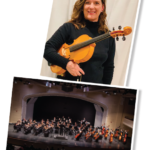He explains that VSA hands out two types of awards—one for sound and another for craftsmanship. When a violin earns high enough marks in both categories, it earns a coveted gold medal.
But that accomplishment will have to wait until he retires in another five to 10 years. At that point, he plans on devoting much of his time to building “really high-quality instruments,” then experimenting with ways to enhance the sound.
Dr. Higgs spends between 100 and 150 hours making just one violin. Due to his hectic schedule, he finishes one instrument almost every two years.
How’s Your Purfling?
The violin hasn’t changed much since it was introduced in the 16th century, he says. Antonio Stradivari—who’s still the world’s most well-known violin maker, even after his death nearly 300 years ago—changed the length a few millimeters, but everything else basically remained the same.
Dr. Higgs spends between 100 and 150 hours making just one violin. Due to his hectic schedule, he finishes one instrument almost every two years. After making violins first in his basement then in his garage, where summer temperatures typically soar to nearly 100 degrees, he built an air-conditioned workshop adjacent to his garage. “It’s a very comfortable place to work,” he says.
While it doesn’t take much to make a violin sound bad, he says it requires a lot of expertise to make one sound good. Just one mistake during any part of the construction process can negatively impact the sound quality.
The process starts with purchasing basic blocks of wood from specialty distributors. He says the violin’s complex curves are carved to shape with only the sides being bent with hot steam. The back and sides are made from hard, sturdy maple.
There are many other steps, such as carving the scroll, which is a very complicated set of curls. But he says the most difficult challenge is inlaying the purfling, which are the two black lines running down the front and back of the violin. It’s actually three layers of wood—an inlay composed of two black and a white middle layer.
“A violin maker always looks at another violin maker’s purfling,” he says. “That’s the ultimate test of craftsmanship.”
Dr. Higgs recalls his first attempt at making a purfling. He threw it away, then retrieved it out of the garbage the following day. He worked on it until it appeared “reasonable,” he says, adding that an experienced violin maker would call it “amateurish.”

